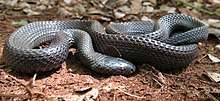Black file snake
The black file snake (Gracililima nyassae), also known commonly as the dwarf file snake or the Nyassa file snake, is a species of snake in the subfamily Lamprophiinae of the family Lamprophiidae.[2] The species is endemic to Africa.
| Black file snake | |
|---|---|
 | |
| Scientific classification | |
| Kingdom: | Animalia |
| Phylum: | Chordata |
| Class: | Reptilia |
| Order: | Squamata |
| Suborder: | Serpentes |
| Family: | Lamprophiidae |
| Genus: | Gracililima Broadley, Tolley, Conradie, Wishart, J.-F. Trape, Burger, Kusamba, Zassi-Boulou & Greenbaum, 2018 |
| Species: | G. nyassae |
| Binomial name | |
| Gracililima nyassae (Günther, 1888) | |
| Synonyms[2] | |
| |
Taxonomy
Gracililima nyassae is the only species in the genus Gracililima. The species was previously placed in the genera Gonionotophis, Mehelya, and Simocephalus.
Etymology
The generic name, Gracililima is from Latin gracili- meaning "slender" + lima meaning "file".[2] The specific name, nyassae, refers to the type locality, "Lake Nyassa" (= Lake Malawi).[3]
Geographic range
G. nyassae is found in Botswana, Burundi, Democratic Republic of the Congo, Kenya, Malawi, Mozambique, Namibia, Rwanda, Somalia, South Africa, Swaziland, Tanzania, Zambia, and Zimbabwe.[2]
Description
G. nyassae is a small snake. The female may attain a snout-to-vent length (SVL) of 52 cm (20 in). The male is shorter, around 44 cm (17 in) SVL. Dorsally it is dark brown or purplish brown, with pink skin showing between the scales. Unlike the Common File snake, this snake lacks the light dorsal stripe but has the characteristic triangular body [4] , Ventrally it is black to dark olive (uniform phase), or cream-olive to white (bicolored phase).[2][5]
Reproduction
The black file snake is oviparous. The female may lay as many as six eggs.[5]
References
- Spawls S (2018). "Gracililima nyassae " (amended version of 2010 assessment). The IUCN Red List of Threatened Species 2018: e.T176862A128729307. https://dx.doi.org/10.2305/IUCN.UK.2010-4.RLTS.T176862A128729307.en. International Union for Conservation of Nature and Natural Resources. Downloaded on 20 December 2018.
- Species Gracililima nyassae at The Reptile Database . www.reptile-database.org.
- Günther (1888).
- "black file snake". africansnakebiteinstitute.
- Branch, Bill (2004). Field Guide to Snakes and other Reptiles of Southern Africa. Third Revised edition, Second Impression. Sanibel Island, Florida: Ralph Curtis Books. 399 pp. ISBN 0-88359-042-5. (Mehelya nyassae, p. 79 + Plate 36).
Further reading
- Broadley, Donald G.; Tolley, Krystal A.; Conradie, Werner; Wishart, Sarah; Trape, Jean-François; Burger, Marius; Kusamba, Chifundera; Zassi-Boulou, Ange-Ghislain; Greenbaum, Eli (2018). "A phylogeny and genus-level revision of the African file snakes Gonionotophis Boulenger (Squamata: Lamprophiidae)". African Journal of Herpetology 67: 43–60. (Gricililima, new genus).
- Boulenger GA (1893). Catalogue of the Snakes in the British Museum (Natural History). Volume I., Containing the Families ... Colubridæ Aglyphæ, part. London: Trustees of the British Museum (Natural History). xiii + 448 PP. + Plates I-XXVIII. (Simocephalus nyassæ, p. 347 + Plate XXIII, figures 2, 2a).
- Günther A (1888). "Contribution to the Knowledge of Snakes of Tropical Africa". Annals and Magazine of Natural History, Sixth Series 1: 322–335. (Simocephalus nyassae, new species, p. 328).
